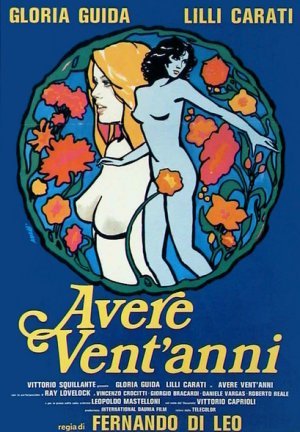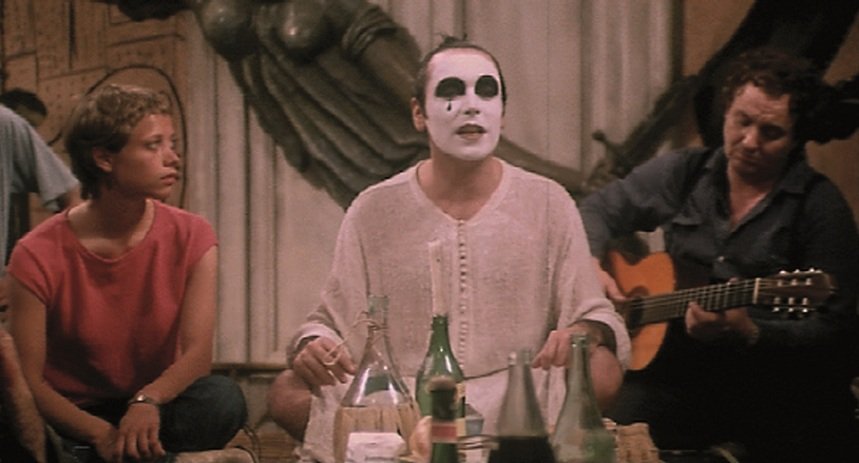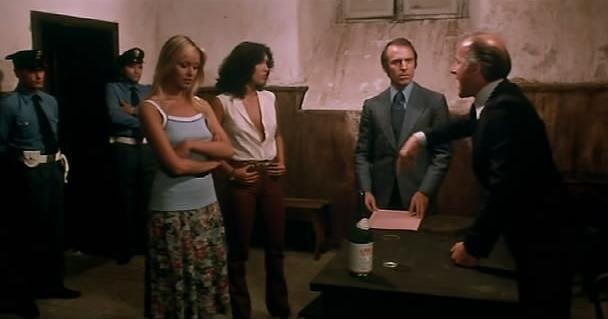TO BE TWENTY: Young, Beautiful, Pissed Off... And Trapped
The 1970's was the definitive decade for shocking downer endings in movies. Whether you were watching exploitation fare or mainstream Hollywood films, you could never be sure if the film you were watching would have a sudden, nasty string in the tail. This was doubly true for European filmmakers, who had enjoyed a greater freedom in this area for many years and didn't hesitate to get down with the 1970's downbeat-ending zeitgeist. Italy in particular took to this trend nicely: the horror and crime fare that Italy cranked out during this era is chockablock with shocker finales designed to send the viewer out frazzled. To Be Twenty is perhaps the most infamous example of this trend amongst fans of Italian genre fare. Even diehard grindhouse aficionados might find themselves weak in the knees at the way this film pulls a bait-and-switch on the audience.On the surface, To Be Twenty seems to be a fizzy blend of youth culture cash-in and comedic sexploitation. The first scene introduces us to our heroines, Tina (Lilli Carati) and Lia (Gloria Guida). They are penniless but spirited as they wander their way through Rome. Both have their reasons for dropping out of "the straight life": hot-tempered Tina is rebelling against a bourgeois upbringing while Lia comes from humble circumstances and is interested in exploring the world.
Italy in particular took to this trend nicely: the horror and crime fare that Italy cranked out during this era is chockablock with shocker finales designed to send the viewer out frazzled. To Be Twenty is perhaps the most infamous example of this trend amongst fans of Italian genre fare. Even diehard grindhouse aficionados might find themselves weak in the knees at the way this film pulls a bait-and-switch on the audience.On the surface, To Be Twenty seems to be a fizzy blend of youth culture cash-in and comedic sexploitation. The first scene introduces us to our heroines, Tina (Lilli Carati) and Lia (Gloria Guida). They are penniless but spirited as they wander their way through Rome. Both have their reasons for dropping out of "the straight life": hot-tempered Tina is rebelling against a bourgeois upbringing while Lia comes from humble circumstances and is interested in exploring the world. The film follows this duo as they make their way in and out of countess shady situations. They share an aversion to living by society's rules and a love of good times (especially sex) so they ultimately end up in a commune that Lia heard about. Life isn't easy but they're both happy to live it on their own terms. Unfortunately, the wrong kind of attention falls on the commune - and this sets the stage for a tragic finale of the "punch to the gut" variety.
The film follows this duo as they make their way in and out of countess shady situations. They share an aversion to living by society's rules and a love of good times (especially sex) so they ultimately end up in a commune that Lia heard about. Life isn't easy but they're both happy to live it on their own terms. Unfortunately, the wrong kind of attention falls on the commune - and this sets the stage for a tragic finale of the "punch to the gut" variety. To Be Twenty is one of those films that is defined by the wallop its ending packs, for better or worse. Nothing in the preceding 80 minutes of the film gives you any indication of what terrors the last 10 minutes hold - and it leaves the viewer with a bone-chilling case of bad vibes. As a result, this ending tends to color how the film is seen as a whole: some look at it as having a reactionary attitude towards its heroines, possibly even a sexist attitude. This is unfortunate because another reading of the film suggests that those sorts of attitudes are exactly what the film is a pointed response to.
To Be Twenty is one of those films that is defined by the wallop its ending packs, for better or worse. Nothing in the preceding 80 minutes of the film gives you any indication of what terrors the last 10 minutes hold - and it leaves the viewer with a bone-chilling case of bad vibes. As a result, this ending tends to color how the film is seen as a whole: some look at it as having a reactionary attitude towards its heroines, possibly even a sexist attitude. This is unfortunate because another reading of the film suggests that those sorts of attitudes are exactly what the film is a pointed response to. In fact, To Be Twenty is a real work of subversive filmmaking. A big part of this is the filmmaker behind the directorial wheel: Fernando DiLeo was best known for a string of tough, darkly witty action films like Manhunt and Milan Calibre 9. An important part of what made those films so special was how they also doubled as social critiques, exploring how corruption affected the working class in Italy. He pulls off a similar trick in To Be Twenty, except this time his theme is how provincial attitudes are more dangerous to a
In fact, To Be Twenty is a real work of subversive filmmaking. A big part of this is the filmmaker behind the directorial wheel: Fernando DiLeo was best known for a string of tough, darkly witty action films like Manhunt and Milan Calibre 9. An important part of what made those films so special was how they also doubled as social critiques, exploring how corruption affected the working class in Italy. He pulls off a similar trick in To Be Twenty, except this time his theme is how provincial attitudes are more dangerous to a  society than the rebellious outsiders that its upstanding citizens fear and resent. It's particularly interesting that he chose women for his main characters, because it also allows him to work in sexism as part of the provincial attitudes he critiques.That might sound a little overtly intellectual given how To Be Twenty devotes much of its time to exploitation tropes. Carati and Guida were amongst the top sexbombs of Italian genre filmmaking during the mid-to-late 1970's and DiLeo misses no chance to exploit their gorgeous physiques onscreen. That said, it's interesting to note how he often defies expectations - a foursome sex scene involving the
society than the rebellious outsiders that its upstanding citizens fear and resent. It's particularly interesting that he chose women for his main characters, because it also allows him to work in sexism as part of the provincial attitudes he critiques.That might sound a little overtly intellectual given how To Be Twenty devotes much of its time to exploitation tropes. Carati and Guida were amongst the top sexbombs of Italian genre filmmaking during the mid-to-late 1970's and DiLeo misses no chance to exploit their gorgeous physiques onscreen. That said, it's interesting to note how he often defies expectations - a foursome sex scene involving the two ladies ends with unexpected speed when the men lose interest, leaving the women unsatisfied and frustrated.There are also several scenes with the heroines being leered at by men where the men are painted in an unflattering light and sometimes even taunted by the women for their lecherous attitudes. In the spirit of Corman-style drive-in feminism, the women are the sexual aggressors and do things on their own terms. It's a telling touch that the most erotic scene involves the two making out with each other once the men have failed them.
two ladies ends with unexpected speed when the men lose interest, leaving the women unsatisfied and frustrated.There are also several scenes with the heroines being leered at by men where the men are painted in an unflattering light and sometimes even taunted by the women for their lecherous attitudes. In the spirit of Corman-style drive-in feminism, the women are the sexual aggressors and do things on their own terms. It's a telling touch that the most erotic scene involves the two making out with each other once the men have failed them. With this in mind, perhaps it is best to view To Be Twenty as a film that uses seemingly innocuous genres - the youth culture movie, the sex comedy - as tools to disarm the audience on the way to its slap-in-the-face ending. DiLeo delivers the skin, broad humor and colorful photography expected from such films, even tarting up the soundtrack with au-courant disco tunes. The first two acts of the film might be lighthearted and full of comic scenes but there is also a subtle undertone of unrest between the heroines and most members of straight society, who make a point of showing their resentment and disapproval of the two.
With this in mind, perhaps it is best to view To Be Twenty as a film that uses seemingly innocuous genres - the youth culture movie, the sex comedy - as tools to disarm the audience on the way to its slap-in-the-face ending. DiLeo delivers the skin, broad humor and colorful photography expected from such films, even tarting up the soundtrack with au-courant disco tunes. The first two acts of the film might be lighthearted and full of comic scenes but there is also a subtle undertone of unrest between the heroines and most members of straight society, who make a point of showing their resentment and disapproval of the two. This undercurrent bubbles to the surface when the police raid the commune and bring everyone in for questioning. Though these scenes are played for over-the-top humor, the text of these scenes reinforces the idea that it's very easy for respectable society to make a victim of its outsiders - and that's doubly true for the female outsiders. Thus, the stage is set for the third act - which maintains the same 'outsiders vs. straights' tension but drops the humor entirely to take the audience into dark, unnerving territory.
This undercurrent bubbles to the surface when the police raid the commune and bring everyone in for questioning. Though these scenes are played for over-the-top humor, the text of these scenes reinforces the idea that it's very easy for respectable society to make a victim of its outsiders - and that's doubly true for the female outsiders. Thus, the stage is set for the third act - which maintains the same 'outsiders vs. straights' tension but drops the humor entirely to take the audience into dark, unnerving territory. Finally, it's worth noting that the whiplash shock of the ending works so well because Lia and Tina are such likeable characters. Most of the peripheral characters in To Be Twenty are cartoons but DiLeo actually takes the time to let us get to know our heroines: his best achievement in this area is a stunning scene where a visiting documentary crew get the two heroines to reveal the backstories. It's a moment where the humor is completely sidelined to show the heroines as thinking, feeling human beings.
Finally, it's worth noting that the whiplash shock of the ending works so well because Lia and Tina are such likeable characters. Most of the peripheral characters in To Be Twenty are cartoons but DiLeo actually takes the time to let us get to know our heroines: his best achievement in this area is a stunning scene where a visiting documentary crew get the two heroines to reveal the backstories. It's a moment where the humor is completely sidelined to show the heroines as thinking, feeling human beings. That amazing scene is also a testament to how good Carati and Guida's performances are. Neither one relies on their looks to do the work for them. Carati brings a fiery energy to her work and shows a real knack for comedy: one of her best scenes involves her getting a professor type all hot and bothered. Guida provides a memorable contrast to her onscreen partner by going the subtle route, projecting an ethereal sense of cool as the more thoughtful member of the duo. A scene where she gently rebuffs an attempted seduction
That amazing scene is also a testament to how good Carati and Guida's performances are. Neither one relies on their looks to do the work for them. Carati brings a fiery energy to her work and shows a real knack for comedy: one of her best scenes involves her getting a professor type all hot and bothered. Guida provides a memorable contrast to her onscreen partner by going the subtle route, projecting an ethereal sense of cool as the more thoughtful member of the duo. A scene where she gently rebuffs an attempted seduction  from a customer is one of her best moments here, a nicely understated piece of work. By the time the end of the film arrives, their work has gotten the viewer invested in these characters - and that really adds a sting to their ultimate fates.To sum up, To Be Twenty is every bit as shocking as you might have heard - but it's there's a genuine motivation behind the big shock and the subversive agenda behind it is what gives the shock its real power.
from a customer is one of her best moments here, a nicely understated piece of work. By the time the end of the film arrives, their work has gotten the viewer invested in these characters - and that really adds a sting to their ultimate fates.To sum up, To Be Twenty is every bit as shocking as you might have heard - but it's there's a genuine motivation behind the big shock and the subversive agenda behind it is what gives the shock its real power.


